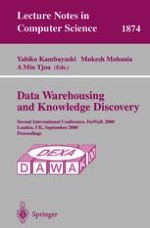The Second International Conference on Data Warehousing and Knowledge Discovery (DaWaK 2000) was held in Greenwich, UK 4–6 September. DaWaK 2000 was a forum where researchers from data warehousing and knowledge discovery disciplines could exchange ideas on improving next generation decision support and data mining systems. The conference focused on the logical and physical design of data warehousing and knowledge discovery systems. The scope of the papers covered the most recent and relevant topics in the areas of data warehousing, multidimensional databases, OLAP, knowledge discovery and mining complex databases. These proceedings contain the technical papers selected for presentation at the conference. We received more than 90 papers from over 20 countries and the program committee finally selected 31 long papers and 11 short papers. The conference program included three invited talks, namely, “A Foolish Consistency: Technical Challenges in Consistency Management” by Professor Anthony Finkelstein, University College London, UK; “European Plan for Research in Data Warehousing and Knowledge Discovery” by Dr. Harald Sonnberger (Head of Unit A4, Eurostat, European Commission); and “Security in Data Warehousing” by Professor Bharat Bhargava, Purdue University, USA.
